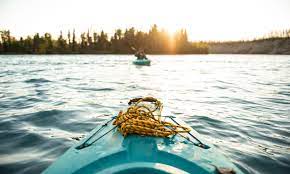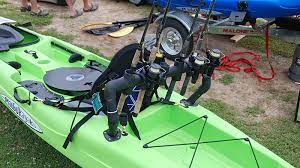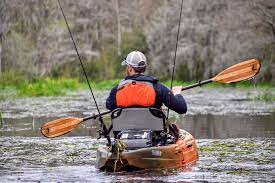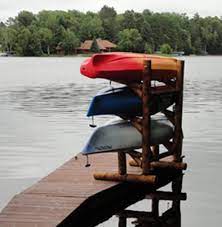We’ve all been there, gliding through the calm waters with the wind in our hair and a sense of adventure in our hearts.
But what if we told you that you can take your kayaking experience to new heights with some simple DIY modifications?
That’s right, fellow kayakers, get ready to elevate your game with these practical and easy-to-follow ideas.

From essential gear modifications to personalized exterior designs, we’ve got you covered.
So grab your tools and let’s dive into a world of creativity and customization for avid kayakers like us.
Key Takeaways of DIY Ideas for Avid Kayakers
- Personalize your kayak with homemade modifications and storage solutions for a comfortable and organized kayaking experience.
- Save money by creating your own kayak accessories such as outriggers, flotation devices, and gear storage systems.
- Repurpose materials like PVC pipes, mesh laundry bags, and waterproof fabrics to make eco-friendly and cost-effective gear for kayaking.
- Upgrade your kayak with creative modifications like adjustable seats, bungee cord systems, and inflatable lumbar support pillows for enhanced comfort and safety.
Essential Gear Modifications
To improve your kayaking experience, you’ll want to make some essential gear modifications. One important aspect is ensuring your safety while out on the water. Consider creating homemade safety equipment such as a personal flotation device (PFD) using foam blocks and straps. This will provide the necessary floatation and keep you safe in case of an emergency.

Another area to focus on is enhancing your comfort during long hours of paddling. DIY kayak seat improvements can be made by adding extra cushioning or padding to your existing seat. You could also experiment with different materials to find what works best for you. A comfortable seat will prevent discomfort and allow you to fully enjoy your time on the water.
Now that we have covered gear modifications that prioritize safety and comfort, let’s move on to discussing homemade storage solutions for your kayaking adventures.
Homemade Storage Solutions
For avid kayakers looking for homemade storage solutions, there’s no better option than utilizing clever DIY ideas.
When it comes to kayak organization, having proper storage is essential for a smooth and enjoyable paddling experience. Here are four practical and inexpensive ideas to help you keep your gear organized and easily accessible:
- PVC Pipe Storage: Create a custom storage system by cutting PVC pipes into various lengths and attaching them vertically on the inside of your kayak. This will provide secure compartments for storing smaller items such as fishing rods or water bottles.
- Bungee Cord Netting: Attach bungee cords across the front or sides of your kayak to create a netting system that can hold larger items like dry bags or camping equipment.
- Mesh Bag Attachments: Repurpose mesh laundry bags by attaching them with carabiners to the rigging on your kayak. These bags are perfect for storing wet gear or collecting trash while out on the water.
- Homemade Waterproof Bags: Use heavy-duty trash bags or dry sacks to create homemade waterproof bags for storing extra clothes, snacks, or electronics. Simply seal them tightly using zip ties or duct tape.
With these simple DIY solutions, you’ll have a well-organized kayak that is ready for any adventure!
DIY Kayak Accessories
Looking to upgrade your kayak accessories? Check out these easy and affordable ways to customize your gear. As avid kayakers ourselves, we understand the importance of having the right equipment to enhance your fishing experience. One DIY idea that can greatly improve your fishing capabilities is making homemade kayak outriggers. By attaching outriggers on either side of your kayak, you can increase stability and prevent tipping over while reeling in those big catches. To help you get started, here’s a simple guide:
| Materials Needed | Instructions | Benefits |
|---|---|---|
| PVC pipes | Measure and cut the desired length for the outriggers. | Provides extra stability while fishing. |
| Connectors and caps | Assemble the PVC pieces together using connectors and secure them with caps. | Easy to assemble and disassemble for storage purposes. |
| Mounting brackets | Attach the assembled outriggers onto your kayak using mounting brackets. | Allows you to easily remove or adjust the outriggers as needed during different kayaking activities. |
With just a few materials and some basic tools, you can create your own homemade kayak outriggers for a fraction of the cost compared to buying them pre-made. Happy DIY kayaking!
Repurposed Materials for Kayaking
Looking for ways to make your kayaking experience more eco-friendly, creative, and budget-friendly? In this discussion, we’ll explore the world of repurposed materials for kayaking.
Discover how you can create your own DIY gear using sustainable materials.
Learn about unique kayak modifications that can enhance your paddling adventures.

Find out some clever hacks to repurpose everyday items into useful accessories for your kayak.
Get ready to elevate your kayaking game while reducing waste and saving money!
Eco-Friendly DIY Gear
Using recycled materials, you can create eco-friendly DIY gear for your kayaking adventures. Here are four ideas to get you started:
- Eco-Friendly Kayak Cleaning Kit: Make your own cleaning solution using natural ingredients like vinegar and lemon juice. Use biodegradable brushes and sponges to scrub away dirt without harming the environment.
- Sustainable Kayak Transportation Options: Instead of using foam blocks or plastic racks to transport your kayak, consider repurposing old pool noodles or creating a homemade wooden rack. These alternatives are not only eco-friendly but also cost-effective.
- Reusable Water Bottles: Stay hydrated on your kayaking trips by bringing along reusable water bottles made from stainless steel or BPA-free plastic. Avoid single-use plastic bottles that contribute to pollution.
- Upcycled Dry Bags: Repurpose old shower curtains or waterproof fabrics into DIY dry bags for storing your belongings during kayaking trips. This way, you can keep your items dry while reducing waste.
By incorporating these eco-friendly DIY gear ideas into your kayaking routine, you can enjoy nature while minimizing your environmental impact.
Now let’s explore some creative kayak modifications that will enhance your paddling experience even further!
Creative Kayak Modifications
To enhance your paddling experience, why not try adding a comfortable seat cushion and adjustable footrests to your kayak? These simple modifications can make a world of difference in terms of comfort and stability.
But why stop there? Let’s get creative and explore some innovative ideas for kayak storage and seating.

One clever storage solution is to attach a mesh bag to the back of your seat. This allows you to easily access items like sunscreen, snacks, and water bottles without having to reach behind you or rummage through a bulky dry bag.
Another option is installing a bungee cord system on the deck of your kayak. This provides a secure way to store larger items such as camping gear or fishing rods.
When it comes to seating, consider customizing your kayak with an inflatable lumbar support pillow. This will provide extra back support during long paddling trips. Additionally, installing detachable thigh supports can help alleviate muscle fatigue by providing extra stability and control.
Budget-Friendly Repurposing Hacks
After exploring creative modifications for our kayaks in the previous section, let’s delve into budget-friendly repurposing hacks to upgrade our kayak seats and enhance safety. Here are four practical ideas to consider:
- Foam Cushioning: Add comfort to your kayak seat by attaching a foam cushion or pad. This simple modification can make long paddling trips more enjoyable.
- Backrest Extension: Extend the backrest of your kayak seat by using PVC pipes or sturdy rods. This will provide better support for your lower back and help prevent discomfort during extended periods on the water.
- Attach Safety Flag: Enhance visibility on the water by attaching a bright-colored safety flag to your kayak. This will make you more noticeable to other boaters, especially in busy areas.
- Additional Floatation Devices: Increase safety while kayaking by affixing additional floatation devices such as inflatable bags or foam blocks inside the bow and stern compartments of your kayak. These will provide extra buoyancy in case of an emergency.
Now that we’ve discussed some budget-friendly upgrades and safety modifications for our kayaks, let’s move on to customizing our paddles in the next section.
Customizing Your Paddles
When it comes to customizing our paddles, there are several key points to consider.
First, we can explore different grip options that suit our individual preferences and enhance our paddling experience. Whether it’s a soft foam grip or a textured rubber handle, finding the right grip can greatly improve comfort and control on the water.
Additionally, adding personalized designs to our paddles allows us to showcase our unique style and make them truly our own.
Finally, opting for lightweight materials not only reduces fatigue during long kayaking sessions but also increases efficiency in maneuvering through water.
Grip Options for Paddles
You can enhance your paddling experience by exploring different grip options for your paddle. Having the right grip can make a huge difference in comfort and control while out on the water.
Here are four alternative grips to consider:
- T-Grip: This ergonomic design allows for a natural hand position, reducing strain and fatigue during long paddling sessions.
- Palm Grip: The palm grip provides a secure hold by wrapping around the shaft of the paddle, giving you maximum control and stability.
- Bent Shaft: This grip option features a bent portion near the blade, which aligns your wrist with your forearm for improved efficiency and power transfer.
- Contoured Grip: Designed to fit the shape of your hand, this grip option offers excellent support and minimizes slippage.
Adding Personalized Designs
To add a personal touch to your paddle, consider customizing it with unique designs and patterns. Personalized kayak decals and custom kayak paint jobs are great ways to make your paddle stand out on the water.
When it comes to decals, you can choose from a wide range of designs, including nature scenes, tribal patterns, or even your own initials. These decals are easy to apply and can be removed without damaging the paddle.
If you’re feeling more adventurous, you can also opt for a custom paint job. With this option, you have complete creative control over the design and colors of your paddle.
Whether you choose decals or paint, adding personalized touches to your paddle is a fun way to express your style and make your kayak truly unique.
Now that you’ve customized your paddle, let’s talk about lightweight materials for efficiency.
Lightweight Materials for Efficiency
Now that we’ve discussed adding personalized designs to our kayaks, let’s move on to the next exciting subtopic: lightweight materials for efficiency. When it comes to kayaking, every ounce matters. Using lightweight construction techniques can greatly enhance our paddling experience and make it easier for us to navigate through the water.
Here are four DIY paddle design ideas that will help us achieve a lighter and more efficient kayak:
- Carbon Fiber Paddle: Carbon fiber is known for its strength and lightness, making it an excellent choice for paddle construction.
- Foam Core Blade: By incorporating a foam core into our paddle blades, we can reduce weight without sacrificing durability.
- Hollow Shaft: Opting for a hollow shaft design allows us to shave off additional weight while maintaining rigidity.
- High-Tech Materials: Exploring innovative materials like Kevlar or fiberglass composites can further reduce paddle weight.
Building Your Own Kayak Cart
Building your own kayak cart can save you money and provide a customized solution for transporting your kayak. When constructing your cart, consider incorporating folding options for portability. This allows you to easily pack and store the cart when not in use.
One option is to use hinges or removable parts that allow the cart to be folded flat or disassembled for convenient transportation. Additionally, choosing the right wheels is crucial for ensuring smooth and easy movement of your kayak. Opt for large, durable wheels with good traction on various terrains such as sand, gravel, or pavement.
Pneumatic wheels are a popular choice as they provide excellent shock absorption and stability over rough surfaces. Remember to take into account the weight of your kayak when selecting wheels, ensuring they can support the load without any issues.
Personalizing Your Kayak’s Exterior
When personalizing your kayak’s exterior, you can use vinyl decals to add a unique and stylish touch. Here are four ideas for personalizing the colors and adding some flair to your kayak:
- Customized Decals: Choose decals that reflect your personality or interests. You can find a wide variety of designs, from nature themes to sports logos.
- Name or Initials: Add your name or initials using vinyl lettering. This not only adds a personal touch but also helps identify your kayak in case of mix-ups.
- Tribal Patterns: Opt for tribal-inspired decals to give your kayak an eye-catching look. These bold patterns can make a statement on the water.
- Wildlife Silhouettes: Consider adding wildlife silhouettes like fish, birds, or turtles to showcase your love for nature while paddling.
DIY Repair and Maintenance Tips
To keep your kayak in top shape, you should regularly inspect the hull for any damages or cracks.
DIY kayak seat upgrades and kayak hull repair techniques are essential for maintaining the longevity and performance of your vessel.
When it comes to upgrading your kayak seat, consider adding extra padding or back support for enhanced comfort during long trips. You can also customize the seat with different materials like neoprene or mesh for improved breathability.
As for repairing the kayak hull, start by identifying any cracks or dents. Use epoxy resin or marine-grade adhesive to fill in and seal these damaged areas. Sand down rough spots and apply a waterproof sealant to protect against future wear and tear.
Frequently Asked Questions
What Are Some Creative Ways to Repurpose Materials for Kayaking That Are Not Mentioned in the Article Section on Repurposed Materials?
There are many creative ways to repurpose materials for kayaking that are not mentioned in the article section on repurposed materials. Some ideas include using old kayaks as planters or creating unique storage solutions for kayaking equipment.
How Can I Personalize My Kayak’s Interior to Make It More Comfortable and Functional?
To personalize our kayak’s interior, we can explore innovative storage solutions such as adding extra compartments or attaching hooks for gear. Additionally, we can enhance seating comfort by using padded seat cushions and adjustable backrests.
What Are Some Common DIY Repair and Maintenance Tips for Kayaks That Are Not Covered in the Article Section on DIY Repair and Maintenance Tips?
When it comes to DIY kayak repair and maintenance, there are a few tips that may not be covered in the article section. We’ll share some insights on DIY kayak storage and homemade kayak accessories.
Are There Any Alternative Methods for Building a Kayak Cart That Are Not Mentioned in the Article Section on Building Your Own Kayak Cart?
Yes, there are alternative methods for building a kayak cart that are not mentioned in the article section. Some unique ways to repurpose materials for kayaking include using a bicycle trailer or modifying a beach cart.
Can You Provide Any Additional Ideas for Customizing the Exterior of a Kayak That Are Not Mentioned in the Article Section on Personalizing Your Kayak’s Exterior?
Sure, we’ve got some additional ideas for customizing the exterior of your kayak. Why not try using repurposed materials like old license plates or colorful duct tape for a unique and eye-catching design?
Conclusion
In conclusion, avid kayakers can enhance their kayaking experience and save money by embracing the DIY spirit. There are numerous ways to customize and personalize kayaking equipment, from making gear modifications to creating storage solutions and DIY accessories. By repurposing materials and building a kayak cart, kayakers can tailor their setup to fit their needs. It’s also important to personalize the kayak’s exterior and learn repair and maintenance tips. So why wait? Dive into these DIY ideas today and take your kayaking adventures to a whole new level! Remember, as the saying goes, “Where there’s a will, there’s a way.”




